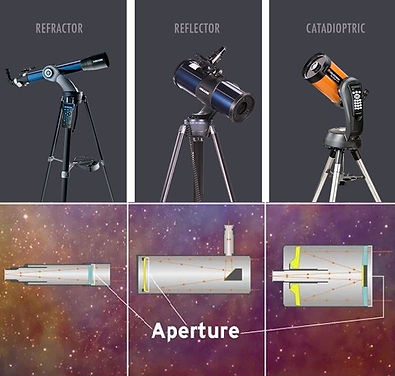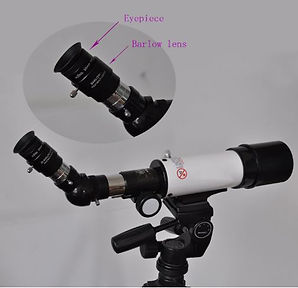The Site is in Under construction
How to use your Telescope?
There are mainly three types of telescopes i.e. Refractor, Reflector and Compound or Catadioptric telescopes. So What is the difference?
Obviously, you can see it in the instructions or on the manufacturer's website but you can identify without it. How? Look inside your telescope tube instead. If you see lens, then it is a refractor. If you see mirrors, its reflector and if you see a lens and mirror, then you have a catadioptric telescope.
In addition, there are two main types of mounts i.e. alt-azimuth mount and an Equatorial mount Also some reflectors have dobsonian mount. If you have Equatorial mount then to work properly it should be aligned with Polaris, the North Star. Please click here for more info.
Also, check How Does a equatorial mount works?


Now let’s discuss about its two main characteristics. The first one is the aperture. Aperture is the diameter of its light gathering lens or mirror, often called the objective. The apertures diameter will be express either in millimeters or less commonly in inches. Please note, the larger the aperture, the more light the telescope can collect and the more objects you can see. In below mentioned picture you can clearly see it. The largest telescope the better.

The second characteristic is Focal length. For refractors and reflectors the focal length is equal to the length of the tube. If you have a catadioptric telescope then it is normal that the length of the tube is not equal to the focal length but these characteristics are written on the tube of your telescope.


Before you start observing, make sure you remove the telescope cover. Most telescopes have small cover inside the larger cover. It is needed in order to make a solar filter from a larger cover for observing the sun. It is not good idea to see sun directly through a telescope; otherwise, you will become blind and will not be able to see the new era of space colonization.

The next important factor are eyepieces. Eyepieces are multi lens components that allow you to achieve different magnifications with your telescope. You cannot start observing without eyepieces. In addition, some numbers always written on the eyepieces. This is eyepieces focal length and using this you can calculate magnification ratio. To do this, we need to divide the focal length of your telescope by the focal length of the eyepiece. For example, if a telescope has a focal length of 700 millimeters and you have a 10 millimeters eyepiece, then the magnification is 700 / 10 or 70 times. Such telescope will give a magnification of 70 times. You can change the magnification by switching eyepieces with different focal lengths. An important point is the maximum magnification that can be obtained on your telescope can be found by mentioned formula. For example, if you are telescope has a 70 millimeters aperture, then we multiply by two and we get that the maximum magnification on this telescope is 140 times. You can visit this site to calculate Magnification of your telescope.

You will find another important stuff mentioned in image below this is Barlow lens. It is needed to increase the magnification of your telescope by a certain number of times. This number written on the Barlow lens itself. How to use the Barlow lens? Take the Barlow lens; insert the eyepieces into the Barlow lens then Insert into the telescope. In addition don't forgot about one more thing i.e. Star diagonal. it is a useful astronomy accessory as it allows viewers to look through their telescope perpendicular to the direction the telescope points or at a 45° angle. its main purpose is more comfortable observation.



In addition don't forgot about one more thing i.e. Star diagonal. it is a useful astronomy accessory as it allows viewers to look through their telescope perpendicular to the direction the telescope points or at a 45° angle. its main purpose is more comfortable observation.

The next thing that many people forget about is the focuser. Focuser is needed in order to focus the image. How to use your focuser? Very simple. Using the knobs on the side, you can shorten or lengthen the distance between the eyepiece and lens of the telescope. Changing this distance allows you to focus on the object in question. Adjust the knobs until you see the image come into a sharp focus.

Last but not the least i.e. FinderScope: A finder-scope is a simple but invaluable accessory that attaches to your telescope. The smaller optical tube provides a wide field of view to help you locate celestial objects before observing them through your main telescope, but it must be aligned accurately to your telescope before use.

Well…now you know how to use your telescope. But before you start your first observations, you need to practice a little during the day. Then in the night, it will be easier for you to observe.
Before observation - Ensure you check light pollution ratio visiting lightpollutionmap.info